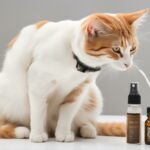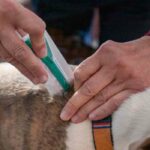As a professional copywriting journalist, I understand the importance of outdoor safety after pesticide use. One question that frequently arises is how long to wait after pesticide spray outside. The wait time after pesticide application is critical as it ensures the pesticide is effective and reduces the risk of harmful exposure to humans and animals.
Different pesticides may have different recommendations for wait time, and it’s essential to read and follow the label instructions to ensure safety. In this article, we will explore the factors affecting wait time after pesticide spray and provide guidelines for outdoor safety following pesticide use.
Key Takeaways
- Waiting for the recommended time after pesticide spray outside is crucial for ensuring safety and reducing the risk of harmful exposure.
- The pesticide label provides specific guidance on wait time and should be read and followed carefully.
- Environmental conditions and the type of pesticide used can impact the required wait time.
- Recommended wait times for common pesticides can provide a general guideline for outdoor safety after treatment.
- Following practical tips and precautionary measures can further reduce risks.
- Seeking professional advice and expertise is essential for responsible pesticide use and tailored recommendations based on specific needs and circumstances.
Understanding Pesticide Label Instructions
As a professional copywriting journalist, I cannot stress enough the importance of reading and following the pesticide label instructions. The label provides critical information regarding the proper use of the product, including wait time guidelines before reentering treated areas.
It is essential to follow the label instructions precisely and use the product as directed to ensure effective treatment and avoid potential safety risks. The label instructions also provide guidelines for appropriate application rates, protective clothing, and storage and disposal instructions.
Remember, the label is the law. Failure to follow the label instructions can result in ineffective treatment, damage to the environment, and even legal consequences.
It is crucial to note that different pesticides may have different wait time instructions, depending on the nature of the product and the target pest. Therefore, it is necessary to check the label carefully and follow the instructions for each particular pesticide used.
Overall, taking the time to read and follow the pesticide label instructions, including the wait time guidelines, is crucial for effective treatment, environmental protection, and ensuring outdoor safety.
Factors Affecting Wait Time After Pesticide Spray
When it comes to outdoor safety after pesticide use, the recommended wait time can vary depending on several factors. These factors include environmental conditions and the type of pesticide used. Here are some important factors that can affect wait time:
| Environmental Condition | Impact on Wait Time |
|---|---|
| Temperature | High temperatures can accelerate pesticide breakdown, potentially reducing the wait time. Low temperatures may slow down pesticide breakdown, causing the wait time to increase. |
| Humidity | Higher humidity levels can slow down pesticide breakdown, meaning a longer wait time may be necessary. Lower humidity can speed up pesticide breakdown, reducing the wait time. |
| Wind Speed | Windy conditions can cause the pesticide to disperse, potentially putting people and pets at risk. If the wind speed is too high, it may be necessary to delay the pesticide application until conditions improve. |
The type of pesticide used can also impact the required wait time. Some pesticides may require longer wait times due to their composition or formulation. It is essential to follow the label directions and wait the recommended time before reentering the treated area.
Understanding the factors that can affect wait time after pesticide spray is critical to ensure outdoor safety. By taking into account these conditions and following recommended wait times, you can help protect yourself, family, and pets from potential harm.
Recommended Wait Times for Common Pesticides
It is essential to wait for the recommended time before re-entering an area that has been treated with pesticides. The wait time varies depending on the type of pesticide used. Here are the recommended wait times for some commonly used outdoor pesticides:
| Pesticide | Wait Time |
|---|---|
| Glyphosate | 0-4 hours |
| Permethrin | 12-24 hours |
| Imidacloprid | 12-24 hours |
| Malathion | 12-24 hours |
It is crucial to follow the pesticide label instructions for the specific product being used as wait time recommendations can vary. In some cases, there may be additional precautions and recommendations provided on the label.
Always ensure that the outdoor safety guidelines are followed before re-entering the treated area. This includes checking that the pesticide has dried and that it is safe to walk on or touch the treated surfaces.
Tips for Ensuring Outdoor Safety Post-Pesticide Spray
After pesticide spray outside, it’s important to take precautionary measures to ensure outdoor safety. Here are some guidelines for post-pesticide application:
- Wear protective clothing: To avoid direct contact with pesticides, wear protective clothing such as gloves, long-sleeves, and pants.
- Take precautions with pets and children: Keep pets and children away from the treated area until it’s safe. Ensure they don’t walk on the area until the recommended wait time has passed.
- Properly clean and store equipment: After use, clean and store equipment properly to avoid any accidental exposure or contamination.
- Wait for the recommended time: Always follow the wait time recommended on the pesticide label before re-entering treated areas.
- Dispose of pesticide containers: Follow the proper disposal guidelines for pesticide containers to avoid environmental contamination.
By following these guidelines, you can ensure outdoor safety after pesticide spray outside and prevent any potential risks to your health and the environment.
Seeking Professional Expertise and Advice
As a professional journalist with experience in the field of pesticide use, I cannot overstate the importance of seeking professional expertise and guidance for outdoor treatment. When it comes to using pesticides, the risks involved cannot be understated, and you must take the necessary steps to ensure that you’re following the proper guidelines to mitigate those risks.
One way to ensure that you’re taking the right precautions is to seek professional advice on pesticide use. Consulting experts in the field can provide you with tailored recommendations based on your specific needs and circumstances. Licensed professionals have the necessary knowledge and expertise to evaluate your situation and provide you with guidance that’s practical, effective, and safe.
Professional advice is especially crucial in situations where you’re dealing with complex pest infestations or environmental concerns. Suppose you’re unsure about the best course of action for treating your garden or lawn after pesticide spray outside. In that case, consulting with a professional can give you peace of mind and help you make informed decisions that prioritize the safety of your family and pets.
Another key advantage of seeking professional advice is that you gain access to outdoor treatment guidance that’s been tried and tested. Professionals have the experience and knowledge to recommend the best practices for pest control that have been proven to work. They have access to the latest information on product application techniques, treatment methods, and the potential risks and benefits of different pesticides.
Ultimately, seeking professional advice on pesticide use is an essential step in ensuring safe and responsible pesticide use. It’s a way to protect yourself, your family, and your environment while still getting the results you need. Don’t take any chances when it comes to pesticide use. Consult with a licensed professional and get the expert guidance you need to make informed decisions about outdoor treatment.
Conclusion
In conclusion, outdoor safety after pesticide spray is paramount. Waiting for the recommended time after application is crucial to ensure effectiveness and reduce potential hazards. As responsible users, we must always read and follow the label instructions for each pesticide used, taking into consideration the environmental conditions and type of pesticide. By taking preventive measures such as wearing protective clothing, keeping pets and children away from the treated area, and properly cleaning and storing equipment, we can further reduce the risks associated with pesticide use.
Let us not forget the importance of enjoying outdoor spaces while ensuring our safety and that of others. Seeking professional advice when needed can provide tailored recommendations that suit specific needs and circumstances. As we continue to utilize pesticides for outdoor treatments, let us embrace responsible pesticide use to maintain a safe and enjoyable environment.
FAQ
Q: How long should I wait after pesticide spray outside?
A: The wait time after pesticide application outside can vary depending on the specific product used. It is important to follow the instructions on the pesticide label for the recommended wait time before reentering treated areas. This wait time ensures your safety and allows the pesticide to effectively do its job.
Q: Why is it important to follow pesticide label instructions?
A: Following the pesticide label instructions is crucial to ensure safe and effective use. The label provides specific guidance on wait time after spray, as well as other important instructions for application and post-treatment precautions. By following these instructions, you can minimize risks and maximize the pesticide’s efficacy.
Q: What factors can affect the wait time after pesticide spray?
A: Several factors can influence the wait time after pesticide spray. Environmental conditions such as temperature, humidity, and wind speed can impact the effectiveness of the pesticide and the required wait time. Additionally, the type of pesticide used may have specific recommendations for wait time based on its mode of action and ingredients.
Q: Are there recommended wait times for common pesticides?
A: Yes, there are general wait time recommendations for common pesticides used in outdoor treatments. These recommendations can be found on the pesticide label instructions. It is important to interpret and follow these guidelines to ensure outdoor safety after pesticide use. If you are unsure, consulting a professional or licensed expert can provide more specific advice.
Q: What are some tips for ensuring outdoor safety after pesticide spray?
A: To ensure outdoor safety after pesticide spray, it is recommended to wear protective clothing, such as gloves and a mask, when handling pesticides. Additionally, taking precautions with pets and children by keeping them away from treated areas is important. Properly cleaning and storing equipment after use can also help minimize risks. Following these tips and practicing responsible pesticide use can contribute to a safe environment.
Q: Should I seek professional expertise and advice regarding pesticide use?
A: Seeking professional advice and expertise when it comes to pesticide use and outdoor treatment is highly recommended. Licensed professionals and specialists can provide tailored recommendations based on specific needs and circumstances. Their knowledge and expertise can ensure the safe and effective use of pesticides, promoting outdoor enjoyment while minimizing potential risks.
- Does Flea Treatment Kill Lice? - September 8, 2023
- Does Flea Treatment Kill Mites? - September 8, 2023
- How to Put Flea Treatment on a Dog? - September 8, 2023






